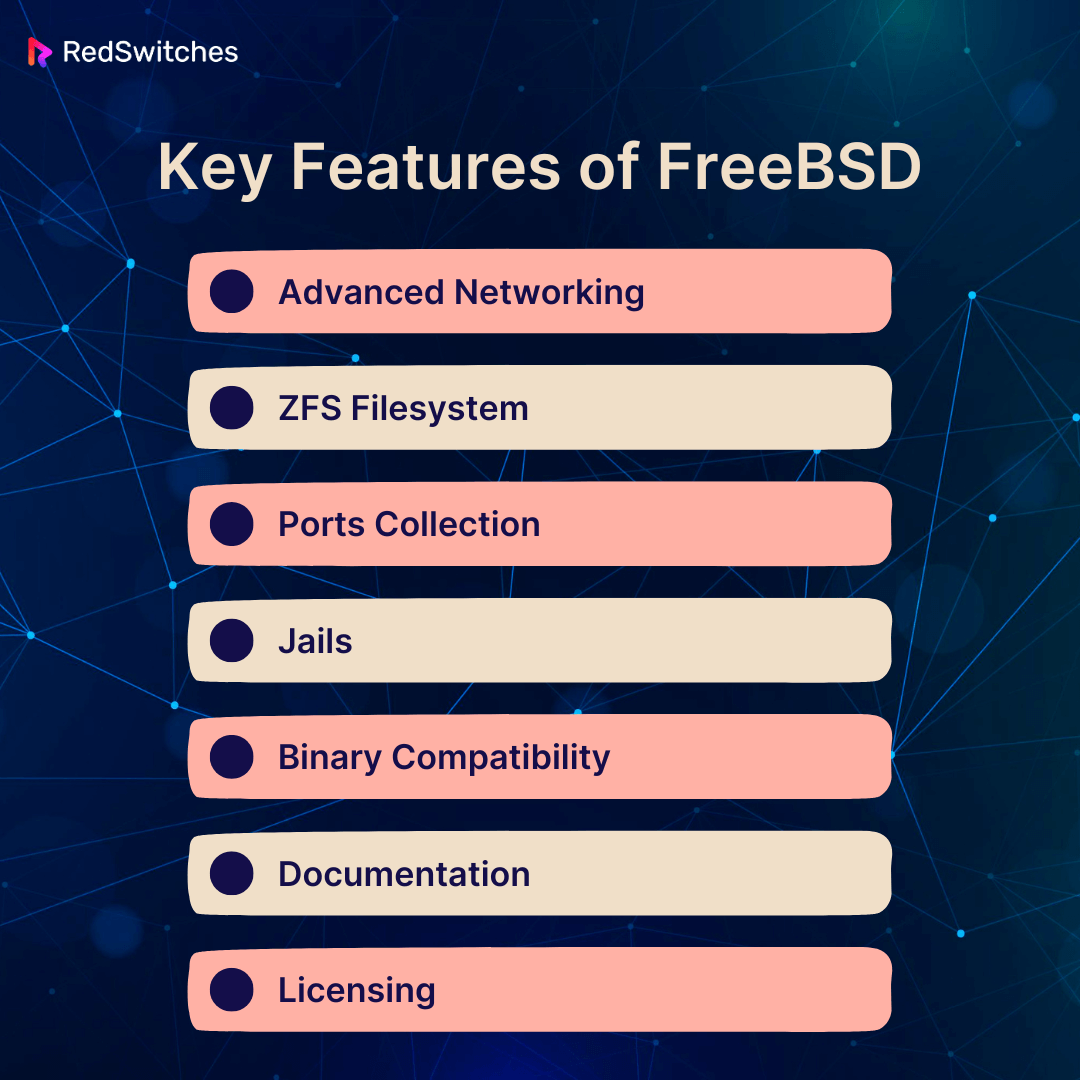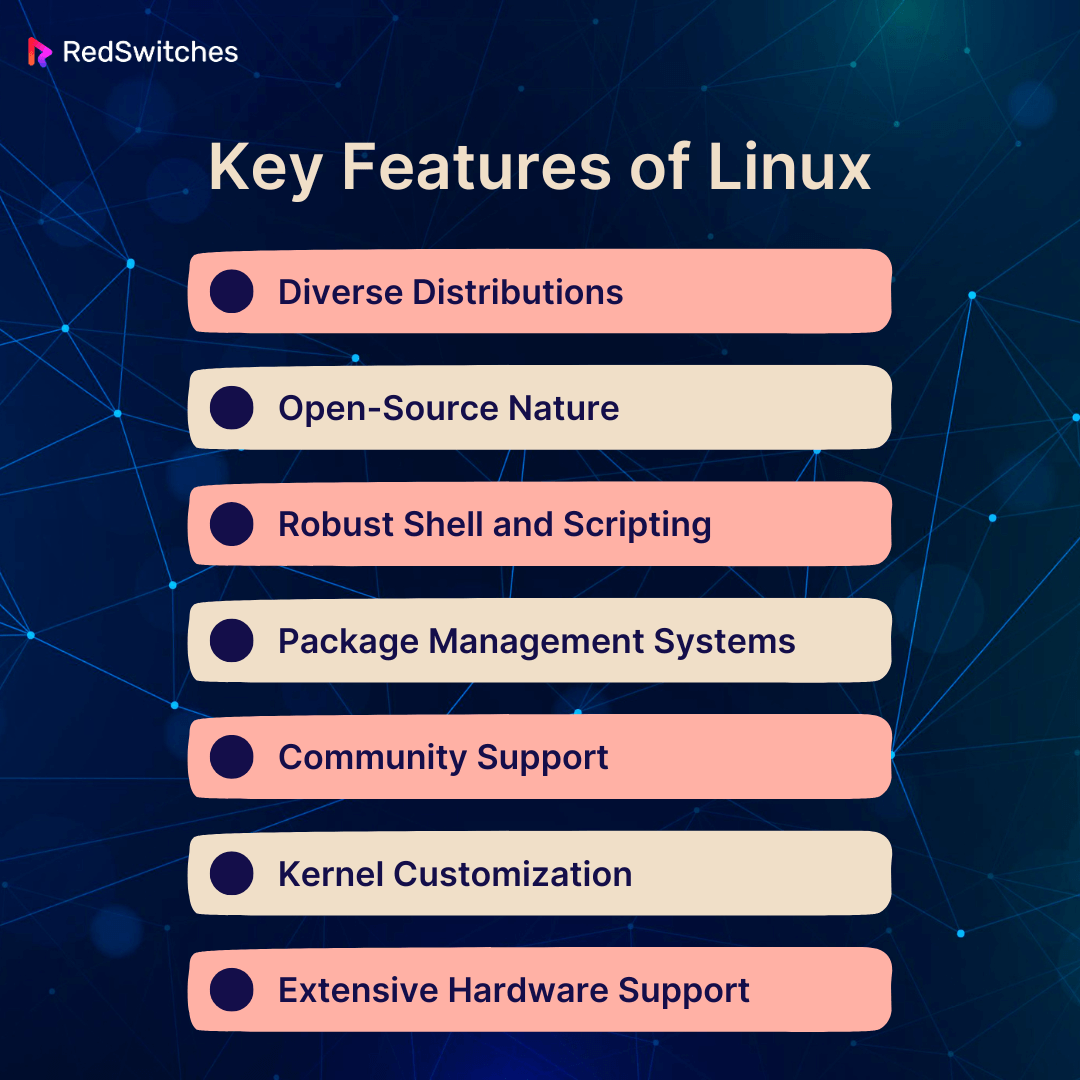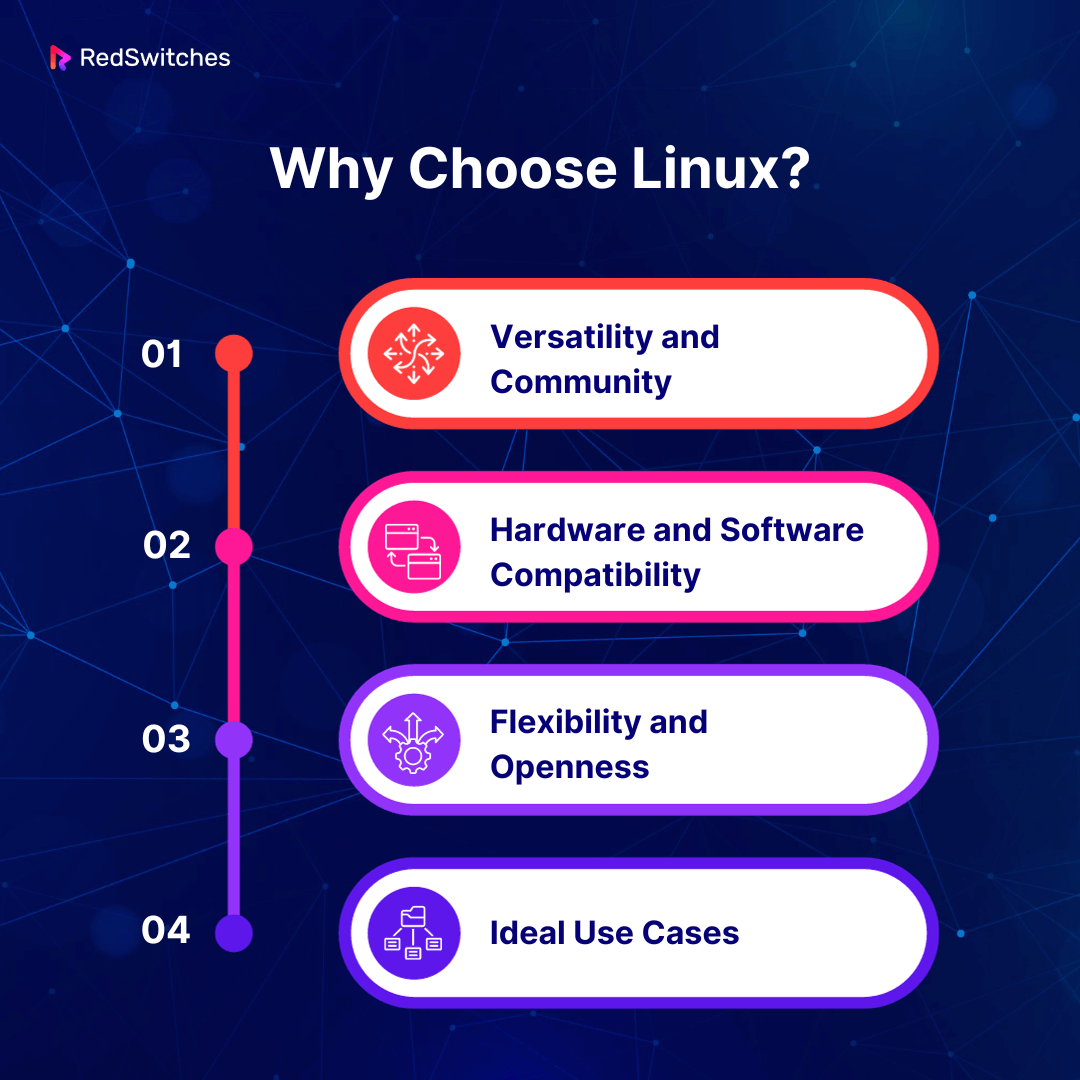In the grand amphitheater of operating systems, two champions have long riveted the crowd: FreeBSD vs Linux. Each is a powerhouse in its own right, forged in the fires of open-source ingenuity and community spirit. Yet, as akin as they might seem to the untrained eye, these two giants differ profoundly in their DNA — from their design principles to their community cultures.
Why does FreeBSD, with its storied lineage and cohesive design, draw a devoted following of aficionados, while Linux, the titan of versatility, dominates the market with its myriad flavors?
In this article, we’ll embark on a journey to unpack the essence of FreeBSD and Linux, comparing their ecosystems, peering into their cores, and shedding light on their unique strengths.
Buckle up for an exploration that’s less about pitting these contenders against each other and more about appreciating the rich tapestry they weave together in the broader universe of operating systems.
Table Of Contents
- What is FreeBSD?
- What is Linux?
- FreeBSD vs Linux: What Are The Differences?
- Why Choose FreeBSD?
- Why Choose Linux?
- Conclusion
- FAQs
What is FreeBSD?
Credit: Freepik
FreeBSD is a robust, open-source operating system derived from BSD (Berkeley Software Distribution), the Unix version developed at the University of California, Berkeley. It’s renowned for its advanced networking, performance, security features, and ability to run on various platforms, from servers to desktops to embedded systems. Its commitment to a cohesive design and system integrity sets it apart, offering users and developers a streamlined, efficient, and stable environment.
Key Features of FreeBSD
- Advanced Networking: FreeBSD is known for its high-quality network performance, making it a preferred choice for network-intensive applications.
- ZFS Filesystem: It supports the robust ZFS filesystem, which provides advanced features like snapshots, replication, and an exceptional integrity check to prevent data corruption.
- Ports Collection: The system includes the Ports Collection, an easy-to-use build system for software that simplifies the installation of applications.
- Jails: It features a robust and lightweight virtualization option called jails, allowing administrators to isolate multiple user-space instances securely.
- Binary Compatibility: FreeBSD offers binary compatibility with Linux, allowing users to run many Linux binaries natively.
- Documentation: Comprehensive documentation is available, often praised for its clarity and utility.
- Licensing: The permissive BSD license is more liberal than the GPL used by Linux, allowing for fewer restrictions on the use of the software.
Pros and Cons of FreeBSD
Pros:
- Performance and Reliability: Known for its system performance, load handling, and uptime reliability, particularly on high-traffic networks and servers.
- File System: With support for ZFS, FreeBSD allows for efficient and robust data management.
- Security Features: Security is a key strength, with features like jails for isolation and a strong, integrated firewall.
- Less Fragmented Ecosystem: The FreeBSD community maintains a single base system, creating a more unified and cohesive operating system environment.
Cons:
- Hardware Support: While extensive, hardware support can lag behind Linux, particularly for the latest hardware.
- Desktop Use: FreeBSD is less commonly used as a desktop operating system, resulting in fewer desktop-oriented applications when compared to Linux.
- Smaller Community: The smaller user base can mean fewer resources for troubleshooting and support, although the community is highly knowledgeable.
- Commercial Software: There’s less commercial software available for FreeBSD, which can be a drawback for users relying on specific proprietary applications.
Below is a table summarizing the pros and cons of using FreeBSD.
What is Linux?
Credit: Freepik
Linux is a free and open-source kernel first released by Linus Torvalds in 1991. Since then, it has become a platform upon which various operating systems, known as distributions, are built.
Linux distributions (distros) offer a variety of systems tailored for different types of users, ranging from newcomers to advanced programmers. They are widely used for servers, desktops, smartphones, and embedded systems. The Linux ecosystem is characterized by its flexibility, community-driven development, and adherence to the principles of free software.
Ready to master your Linux environment? Dive into our comprehensive guide and become a pro at configuring environment variables in Linux today!
Key Features of Linux
- Diverse Distributions: From user-friendly distros like Ubuntu and Mint to more advanced options like Arch and Gentoo, there’s a Linux flavor for everyone.
- Open-Source Nature: Linux’s source code is freely available for anyone to view, modify, and distribute, encouraging a collaborative approach to development.
- Robust Shell and Scripting: The Linux command line is a powerful tool, and shell scripting allows users to automate various tasks.
- Package Management Systems: Linux offers advanced package management systems like APT, YUM, and Pacman, making software installation and maintenance straightforward and efficient.
- Community Support: With a vast community of users and developers, finding help and support resources is often just a forum post away.
- Kernel Customization: Users can customize the Linux kernel to suit their specific needs, which is particularly valuable for performance tuning or running on specialized hardware.
- Extensive Hardware Support: Linux supports a wide range of hardware, from desktops to servers to IoT devices.
Pros and Cons of Linux
Pros:
- Versatility: Linux can be tailored for various systems, from supercomputers to home appliances.
- Software Availability: A vast selection of open-source software is available, and most proprietary desktop software now offers Linux versions.
- Cost: It’s generally free to use, reducing the barrier to entry for individuals and organizations.
- Community and Support: A large, active community offers substantial support through forums, online courses, and documentation.
- Security: Linux is known for its strong security model, making it a popular choice for servers and critical applications.
Cons:
- User-Friendliness: Some users may find certain Linux distributions challenging, especially those that require more command-line interaction.
- Compatibility with Software: While many software developers are now supporting Linux, some industry-standard applications, especially in professional environments, may not have Linux versions.
- Fragmented Ecosystem: The plethora of distributions can lead to fragmentation, potentially creating inconsistencies and compatibility issues.
- Gaming: Although improving rapidly, Linux still lags in terms of native game support when compared to Windows.
Below is a table summarizing the pros and cons of using Linux.
Curious about the perfect browser for your Linux system? Click to explore our top 10 browsers crafted specifically for Linux users!
FreeBSD vs Linux: What Are The Differences?
Credit: Freepik
In this section, “FreeBSD vs Linux: What Are The Differences?”, we’re set to uncover the critical distinctions between these two influential operating systems. We’ll explore their underlying principles, performance aspects, and community support to understand how they stand apart. This is your map to the nuanced terrain of FreeBSD and Linux, guiding you to the OS that aligns with your technical journey. Whether you’re a developer, sysadmin, or tech aficionado, join us as we delve into what sets these two open-source giants apart.
Licensing
As we peel back the layers of the FreeBSD vs Linux debate, the licensing models each employs are pivotal to understand, particularly for developers who foresee modifying the source code. Let’s break down how the licensing of FreeBSD and Linux differ and what that means for users and developers.
FreeBSD
- BSD License: Championing a blend of open-source flexibility and proprietary potential.
- Freedom to Modify: Users can freely change and adapt the source code.
- Distribution Choices: There is no obligation to share modifications supporting proprietary use.
- Private Development: The BSD License allows the creation of closed-source products from its code.
Linux
- GNU General Public License (GPL): A commitment to collaborative, transparent development.
- Open-Source Contribution: Changes to the Linux kernel must be made public, fostering community innovation.
- No Closed-Source: Developing a closed-source system from Linux is impossible, ensuring perpetual openness.
Considerations for Users
- Relevance: The significance of licensing is more pronounced for users interested in modifying and distributing the OS.
- Proprietary Development: FreeBSD may be the preferred choice for developing proprietary solutions.
In the FreeBSD vs Linux discourse, the stark contrast in licensing paradigms guides developers towards the system that best aligns with their project’s goals—open collaboration or proprietary innovation.
Performance and Optimization
Delving deeper into the FreeBSD vs Linux discourse, performance and optimization are key factors that often sway the decision of users looking for an operating system tailored to their needs. Let’s explore how each system fares in these critical areas.
FreeBSD
- Server Optimization: FreeBSD is optimized for server environments, known for its robust stability and reliability.
- Resource Efficiency: It utilizes resources efficiently, ensuring good performance even under demanding tasks.
- Performance Consistency: Offers consistent performance, particularly for network and I/O operations.
Linux
- Scalable Versatility: Linux is renowned for its scalability, making it suitable for everything from desktops to servers.
- Broad Use Case: Performs well across various scenarios, ensuring users have flexibility in deployment.
- Adaptable Performance: It can be tuned for performance in various environments, from cloud infrastructures to personal computing.
Credit: Freepik
Key Takeaways
- Task Suitability: FreeBSD shines in server-specific tasks, while Linux offers more general-purpose versatility.
- Resource Management: Both systems manage resources efficiently but may excel in different contexts—FreeBSD in dedicated server tasks and Linux in diverse environments.
In FreeBSD vs Linux, your performance and optimization requirements might dictate your choice. FreeBSD remains a stronghold for server-oriented tasks, focusing on consistent, efficient performance. Conversely, Linux offers a more adaptable solution, scaling to meet diverse demands from personal computing to enterprise-grade systems.
Security Auditing
Regarding the crucial aspect of security, FreeBSD vs Linux each present compelling features but with notable differences in their default security posture and auditing capabilities. Let’s look at how these two operating systems stack up in security auditing.
FreeBSD
- Security-First Approach: Since its inception, FreeBSD has strongly emphasized security.
- Pre-Integrated Features: It comes with robust, pre-packaged security features out-of-the-box.
- Built-in Auditing: FreeBSD includes a Security Event Auditing system that records and analyzes security events for effective incident response.
Linux
- Configurable Security: Linux is highly secure and can be fortified to meet virtually any security requirement.
- Flexibility: Users can install and configure various security features according to their needs.
- Separate Auditing Tools: While not present by default, Linux can be equipped with comprehensive auditing systems through additional setup.
Assessing the Default Setup
- Out-of-the-Box Security: FreeBSD may edge out Linux with its ready-to-go security features, making it a potentially more secure choice in default configurations.
- Custom Security Solutions: Linux, with its extensive configurability, can match and even exceed FreeBSD’s security—provided that the user has the necessary expertise to implement these features.
In the debate of FreeBSD vs Linux security regarding security auditing, it boils down to the user’s preference between a ready-made secure environment or a customizable one. FreeBSD’s security-first philosophy means it’s already tuned for heightened security from the start, including a comprehensive auditing system. Linux, while not as immediately fortified, offers the potential for high security; it simply requires additional configuration.
Elevate your coding game on Linux! Join us as we unveil the top 10 IDEs that will transform your Linux programming experience.
Operating System
Credit: Freepik
In the ongoing FreeBSD vs Linux conversation, the nature of what constitutes an ‘operating system’ often brings an exciting twist to the comparison. Understanding the fundamental makeup of each is essential for users to decide which aligns best with their needs.
FreeBSD
- Whole OS: FreeBSD is a complete operating system, with kernel and userland tools developed in tandem.
- Unified Development: The FreeBSD project oversees core system components and additional utilities, ensuring consistency.
- Out-of-the-Box Functionality: It provides a ready-to-use operating system environment immediately upon installation.
Linux
- The Kernel: At its heart, Linux is just a kernel, the core that manages the system’s hardware and resources.
- GNU/Linux: Most distributions combine the kernel with GNU system software and libraries to form a complete OS.
- Distribution Diversity: There is a wide array of Linux ‘distros,’ each with its unique selection of software and management tools.
- User Choices: Users can choose from popular distros like Ubuntu, CentOS, Fedora, Arch Linux, Linux Mint, and Debian, each with distinct features and communities.
Evaluating the Differences
- Misconception Clarification: It’s essential to recognize that what is commonly called ‘Linux’ is more accurately a distribution that utilizes the Linux kernel.
- OS Completeness: When considering a ‘complete’ operating system, FreeBSD provides an all-in-one approach, as opposed to the mix-and-match philosophy of Linux distributions.
The distinction between FreeBSD as a whole operating system and Linux primarily as a kernel surrounded by GNU components is crucial for users who value a seamless, integrated system out-of-the-box. FreeBSD’s all-encompassing nature offers a harmonized experience, whereas the Linux ecosystem invites users to select from a mosaic of distributions tailored to different preferences and purposes.
Hardware & Architectural Support
When aligning the aspects of FreeBSD vs Linux, particularly in server applications, the conversation inevitably turns toward hardware compatibility and architectural support.
FreeBSD
- Selective Platforms: FreeBSD supports fewer hardware platforms, but this focus can lead to performance optimizations.
- No Compromise on Performance: FreeBSD can optimize for performance without broad compromise by targeting a narrower range.
- Server-Centric Design: Reflecting its server-oriented approach, FreeBSD excels in stable, high-performance server environments.
Linux
- Extensive Support: Linux boasts broad hardware and architectural support, running on almost any platform imaginable.
- Compatibility Edge: If hardware compatibility is a concern, Linux is more likely to accommodate diverse systems.
- Performance Considerations: Linux sometimes makes performance trade-offs to maintain its broad reach.
- Mainstream Adoption: With Linux’s mainstream appeal, vendors prioritize Linux support, leading to faster updates and broader software availability.
- Driver Updates: Users needing frequent updates, such as those for graphics drivers, will likely find Linux better supported.
Practical Considerations for FreeBSD vs Linux Server Deployment
- Peripheral Support: On the desktop front, FreeBSD’s support for peripherals and graphics cards is less immediate than Linux’s, primarily due to its server-centric focus.
- System Utilization: Decision-making will hinge on how the system is intended to be used, with FreeBSD often being the go-to for dedicated server tasks.
In the FreeBSD vs Linux server debate, your choice might lean towards Linux for general hardware compatibility, mainly if you operate across varied architectures. However, FreeBSD’s streamlined support is advantageous for server-specific deployments where tailored performance and hardware efficiency are paramount. It’s essential to weigh these differences against your use case to determine which system will be the cornerstone of your server infrastructure.
Updates
In the sphere of system maintenance, FreeBSD vs Linux update mechanisms are distinct, each with its own merits in terms of user convenience and update availability.
FreeBSD
- Selective Updating: FreeBSD provides a more granular update process, allowing for detailed update selection.
- Kernel and Core Updates: Users can update core components like the kernel, source code (src), and userland (world).
- Sub-component Control: The option to update only specific sub-components if preferred.
- Streamlined Application: Applying updates in FreeBSD is a straightforward affair, enhancing the user experience.
Linux
- Speed of Availability: Linux typically sees a quicker turnaround for updates, thanks to active development by open-source contributors and corporations.
- Community and Corporate Support: The strong community and commercial backing mean that updates are pushed out rapidly post-development.
- Upstream Project Sync: Linux and FreeBSD often receive updates contemporaneously, drawing from the same upstream sources.
Evaluating Updates
- Convenience vs. Speed: FreeBSD offers update convenience, allowing for a tailored system, while Linux provides speed, ensuring prompt access to the latest features and fixes.
- Project Needs: Users must assess whether the convenience of selective updates or the rapid availability of the latest patches aligns better with their project requirements.
The dichotomy of update convenience in FreeBSD and update speed in Linux heavily influences the decision-making process for system administrators and end-users. FreeBSD’s update methodology is beneficial for those prioritizing a highly customized system. In contrast, Linux’s faster update cycle is more advantageous in environments where having the newest updates as soon as possible is critical. The choice between FreeBSD vs Linux server ecosystems will often come down to these update philosophies and how they fit into the user’s operational workflow.
Package Management
Software installation is a crucial aspect of managing any operating system, and both FreeBSD vs Linux offer unique methodologies for package management, impacting the overall user experience.
FreeBSD
- Extensive Library: FreeBSD boasts a vast Ports collection featuring nearly 40,000 applications.
- Ease of Installation: Users and administrators can quickly and easily install packages.
- Patch Integration: Each port is accompanied by patches to ensure compatibility and seamless functionality on FreeBSD systems.
Linux
- Varied Effectiveness: Linux package managers’ performance can vary significantly depending on the chosen distribution.
- Distribution-Specific Managers: Some notable package managers include
- DPKG: The foundation of package management in Debian-based systems.
- RPM: Utilized by Red Hat and its derivatives for package handling.
- Pacman: The package manager for Arch Linux, renowned for its simplicity and effectiveness.
- Pkgsrc: A versatile package manager that supports multiple platforms.
- Portage: Gentoo‘s advanced package management system that excels in customizability.
- Distribution-Specific Managers: Some notable package managers include
Choosing Package Management
- Collection vs. Manager: FreeBSD’s singular Ports collection contrasts with Linux’s variety of distribution-specific package managers.
- Compatibility and Convenience: FreeBSD’s commitment to ensuring compatibility via patches within its Ports collection can simplify system maintenance.
- Distro-Dependent Experience: With Linux, the ease of software installation highly depends on the distro’s choice and its associated package manager.
Credit: Freepik
In choosing between FreeBSD vs Linux, especially when considering the ease of installing software packages, it’s essential to consider the consistency and breadth of FreeBSD’s Ports collection against the specific capabilities and characteristics of Linux’s assorted package management systems. Your decision might hinge on whether you prefer the uniform approach of FreeBSD or the flexibility and distro-specific advantages that come with Linux’s various package managers.
Governance
When examining the FreeBSD vs Linux ecosystems, the structures of governance and development models offer a window into how each community influences the evolution of their respective operating systems.
FreeBSD
- Core Team Oversight: FreeBSD is stewarded by a 9-member Core Team, democratically elected by its committers.
- Global Committers: Approximately 500 committers contribute to debugging and improving FreeBSD’s source code.
- Volunteer-Driven: Most of these committees are volunteers, fueling the project with their passion for open-source development.
- Election Cycle: Every two years, active committers vote to elect the Core Team to guide the project’s path.
Linux
- Centralized Leadership: The Linux kernel remains under the guidance of Linus Torvalds, who retains the final say on new updates.
- Benevolent Dictatorship: Torvald’s role is often called a “benevolent dictator for life,” denoting his lifelong commitment and ultimate decision-making authority.
- Community Contributions: While Torvalds oversees the kernel, a vast community of developers contributes to its continual development.
Understanding the Impact
- Leadership Styles: FreeBSD’s democratic model contrasts with the more centralized leadership style of Linux.
- Community Input: Both systems rely heavily on global contributions from their communities, but how those contributions are managed and integrated varies.
- Influence on Development: These governance models shape The development process significantly, influencing everything from feature implementation to release schedules.
The governance of FreeBSD and Linux reflects the philosophies and historical contexts from which they emerged. Potential contributors and users should consider how these differences might align with their development philosophies and project needs. Whether one prefers FreeBSD’s more controlled, community-elected approach or the singular vision of Linux’s founder, both systems benefit from active, passionate communities dedicated to advancing the open-source movement.
Customization
When tailoring an operating system to specific needs, the customization capabilities of FreeBSD vs Linux come into sharp focus, each offering a different landscape for users to mold their environment.
FreeBSD
- Consistent Base System: FreeBSD provides a coherent base system, separated from third-party software, offering a stable foundation for customization.
- Ports and Packages: Users can customize their installation through the Ports system, choosing to compile software with specific options or to install pre-compiled binaries.
- Kernel Configuration: There’s a high degree of kernel configurability in FreeBSD, with options to compile a custom kernel tailored to the user’s environment.
Linux
- Multiple Distributions: The Linux ecosystem offers a multitude of distributions, each with its default configurations and customization tools.
- Graphical Interfaces: Many Linux distros have powerful graphical tools that allow users to tweak and optimize the system without diving into the command line.
- Community Scripts and Mods: The larger Linux community provides an abundance of scripts, modifications, and third-party repositories to customize one’s system further.
Weighing the Approach
- Control vs. Convenience: FreeBSD’s approach to customization emphasizes control and a clear separation between base and third-party systems, while Linux focuses on convenience and diversity.
- System Cohesion: With FreeBSD, the customization process may be more manual, but it maintains system cohesion, whereas Linux distros offer more automated tools that can sometimes lead to fragmentation.
- User Skill Level: FreeBSD often attracts users with a deeper technical background willing to engage with system internals. Linux caters to a broader skill range with options for novice and advanced users.
In the FreeBSD vs Linux customization showdown, the choice is between the orderly, hands-on customization offered by FreeBSD and the wide-ranging, user-friendly personalization inherent to the Linux world. FreeBSD’s ports and kernel compilation options appeal to those who enjoy deep diving into system internals. In contrast, Linux’s various distributions and graphical tools serve beginners looking for ease and experts demanding flexibility. Each path offers a unique journey into system customization, shaped by the user’s expertise, needs, and the desired complexity of the customization process.
Not sure which Linux version you’re running? Find out easily—our step-by-step guide walks you through the various methods to check your Linux version.
Community
The communities surrounding FreeBSD vs Linux are the lifeblood of each operating system’s ecosystem, each offering varying degrees of support, resources, and camaraderie to users and developers alike.
FreeBSD
- Dedicated Community: FreeBSD boasts a close-knit community known for its expertise and specialization.
- Active Involvement: Although more compact, the community remains actively involved in support and development.
- Responsive Support: Users often report high-quality interactions and responsiveness from FreeBSD’s mailing lists and forums.
Linux
- Vast and Varied: The Linux community is expansive, with a diverse, global user base contributing to its development and support.
- Extensive Resources: A more prominent community translates to a broader range of support options, from forums and IRC channels to dedicated websites and conferences.
- Software Richness: The sheer size of the Linux community fosters a rich ecosystem of distributions, software, tools, and utilities catering to almost every use case.
Analyzing Community Dynamics
- Quality vs. Quantity: FreeBSD’s smaller but specialized community can offer targeted support, while Linux’s more extensive base provides a broad spectrum of perspectives and solutions.
- Niche vs. Mainstream: FreeBSD tends to attract a niche audience with specific interests in the OS’s core strengths, whereas Linux appeals to a mainstream audience with varying levels of technical ability.
- Support Accessibility: With Linux, the likelihood of finding immediate solutions through community forums or existing documentation is higher due to the sheer number of users and contributors.
In evaluating FreeBSD vs Linux, the community aspect is an essential consideration. FreeBSD may offer a more specialized community with a potential for high-quality support, while Linux provides extensive and varied resources due to its size and popularity. Your engagement level with the community, whether a casual user or a developer, will likely influence your experience and thus may guide your choice between the two operating systems.
Graphics Support
In the Unix-like operating systems landscape, FreeBSD vs Linux present unique offerings regarding graphics support—a crucial factor for users with specific graphical needs.
FreeBSD
- Stable Drivers: FreeBSD’s graphics drivers are known for their stability, making for a dependable system environment.
- Simplified Setup: Configuring graphics support in FreeBSD is typically more straightforward, favoring ease of use.
- Limited Range: The trade-off for stability and simplicity is a narrower selection of supported graphics hardware.
Linux
- Broad Hardware Support: Thanks to many drivers, Linux is often ahead in supporting the latest graphics hardware.
- Intensity-Ready: It’s the go-to choice for graphics-intensive activities, whether gaming, 3D modeling, or video editing.
- Configuration Challenge: Despite its capabilities, setting up Linux graphics drivers can be intricate and requires more technical savvy.
Critical Considerations for Graphics Support
- Hardware Compatibility: Always verify that your graphics hardware is supported by checking the respective hardware compatibility lists for FreeBSD and Linux.
- Technical Comfort Level: Your familiarity with configuring system hardware can make FreeBSD appealing for its ease or Linux for its versatility.
- Software Requirements: Ensure that any graphics-intensive applications you need are compatible with your chosen operating system.
Credit: Freepik
Regarding graphics support within the FreeBSD vs Linux debate, Linux often takes the lead for those requiring cutting-edge support. At the same time, FreeBSD remains a solid contender for users valuing system stability and ease of configuration. The decision will largely depend on your specific hardware, technical expertise, and the demands of the software you intend to use.
Pricing
When considering the cost implications of FreeBSD vs Linux, the primary factor remains that both are inherently free, thanks to their open-source underpinnings. This shared trait places them on equal footing in the initial adoption stage.
Open Source and Free Access
- Zero Licensing Fee: Both operating systems offer the freedom of zero cost for acquiring and using the base system.
- Open Source Benefits: The ability to view, modify, and distribute the source code bolsters flexibility and innovation.
Additional Costs to Consider
- Support Services: While the OS is free, professional support services may incur charges depending on your needs and expertise.
- Hardware Compatibility: Investing in compatible hardware might involve additional expenses, particularly if specific configurations are needed.
Strategic Advantage for Businesses
- Linux’s Sharing Mandate: Modifications to Linux must be made public under the GNU GPL, which can influence a business’s decision if proprietary developments are a concern.
- FreeBSD’s Flexibility: FreeBSD allows businesses to keep modifications private, offering an advantage for proprietary product development.
The Tie Breaker: Use-Case Scenarios
- Free Nature: The tie-in cost-freeness provides a level playing field for individuals and organizations utilizing either system.
- Business Strategy Alignment: Companies may find FreeBSD more aligned with their proprietary strategies due to its more flexible licensing.
In conclusion, while both FreeBSD and Linux stand as cost-free options in terms of initial deployment, the total cost of ownership and strategic implications can vary based on the need for additional services, hardware, and the intended use of the software, especially when considering the integration into proprietary products.
Here is a breakdown of the comparison of FreeBSD vs Linux.
Why Choose FreeBSD?
When navigating the open-source seas, opting for FreeBSD can be a compelling choice for several reasons, each resonating with different user needs and organizational goals.
Stability and Performance
- Predictable Stability: Renowned for its reliability, FreeBSD provides a stable environment for servers and applications requiring consistent performance.
- Performance Tuning: The system is optimized for high-load environments, often outperforming other OSes in network and I/O throughput.
Security and Licensing
- Robust Security: FreeBSD’s security model is mature and time-tested, offering features like Jails for advanced isolation.
- Flexible Licensing: The permissive BSD license allows for modification and proprietary use without the obligation to disclose source code changes.
Community and Customization
- Supportive Community: Access to a knowledgeable and responsive community ensures valuable support for new and seasoned users.
- Ports Collection: With the Ports collection, installing and managing software is streamlined, providing over 30,000 packages with easy customization.
Ideal Use Cases
- Server Deployment: Its server-centric design makes FreeBSD a prime choice for dedicated server tasks.
- Embedded Systems: FreeBSD’s lightweight footprint is well-suited for embedded systems and network appliances.
Choosing FreeBSD means investing in a system that values long-term stability, robust security, and the freedom to tailor your software and hardware solutions as you see fit, all backed by a supportive community.
Why Choose Linux?
Linux is a highly versatile and widely supported operating system, suitable for many environments, from personal computing to enterprise servers.
Versatility and Community
- Diverse Ecosystem: Linux’s broad array of distributions means there’s a tailored solution for virtually any use case.
- Vibrant Community: Benefit from a massive, global community that offers support, collaboration, and innovation.
Hardware and Software Compatibility
- Extensive Hardware Support: With its vast driver support, Linux runs on almost any hardware, from old laptops to modern servers.
- Rich Application Support: A wealth of applications and utilities are available for Linux, catering to general and specialized tasks.
Flexibility and Openness
- Customization Freedom: Linux provides the freedom to tweak and modify your environment to fit precise needs.
- Open Source Philosophy: Embracing the principles of open source, Linux thrives on collaboration and shared progress.
Ideal Use Cases
- Desktop to Data Center: From user-friendly desktop experiences to robust data center management, Linux adapts to your requirements.
- Innovative Technologies: Linux is at the forefront of emerging fields like cloud computing and containerization.
Opting for Linux means joining a dynamic ecosystem constantly evolving, supported by a community eager to push the boundaries of open-source technology. Whether for development, personal use, or enterprise infrastructure, Linux offers an adaptable and feature-rich platform.
Gamers, level up with Linux! Discover the best Linux OS for gaming in 2023 and get ready for an unmatched gaming experience. Click to reveal the top picks!
Conclusion
Regarding FreeBSD vs Linux, each OS offers distinct advantages tailored to different needs—FreeBSD for security and stability, Linux for flexibility, and hardware support. The right choice hinges on the specific demands of your projects and infrastructure.
RedSwitches is your ally in leveraging these operating systems to their fullest potential. With expertise in FreeBSD and Linux environments, RedSwitches provides robust, scalable, and secure hosting solutions that align with your operational goals.
Ready to optimize your hosting with FreeBSD’s reliability or Linux’s versatility? Reach out to RedSwitches for customized solutions that enhance your system’s performance and resilience. Contact RedSwitches now and set the foundation for a future-proof digital presence.
FAQs
Q. What is FreeBSD best used for?
FreeBSD is particularly well-suited for server environments and embedded systems, as it offers robust stability and excellent security features. Its performance and reliability make it a top choice for businesses and individuals who require a dependable operating system for critical applications.
Q. What is the advantage of FreeBSD?
The primary advantage of FreeBSD is its stability and security, packaged in a cohesive operating system that benefits from a permissive licensing model. This makes it ideal for users who need a reliable system that allows for greater flexibility in software distribution and modification.
Q. Can FreeBSD run Linux programs?
Yes, FreeBSD can run Linux programs through its Linux binary compatibility layer. This feature allows users to operate Linux-based software on FreeBSD, effectively bridging the gap between the two systems and expanding the range of applications and tools available to FreeBSD users.
Q. What is the difference between FreeBSD and Linux?
FreeBSD and Linux are both Unix-like operating systems, but they have different kernels and userland utilities. While Linux uses the Linux kernel, FreeBSD uses the FreeBSD kernel.
Q. Why would someone choose FreeBSD over Linux?
Some users prefer FreeBSD over Linux due to its advanced networking capabilities, security features, and ZFS file system. Additionally, FreeBSD’s licensing is different from Linux, which may align better with certain use cases.
Q. How does Linux compare to FreeBSD in terms of popularity and usage?
Linux is generally more popular and widely used compared to FreeBSD. It has a larger user base, extensive community support, and a vast range of available software and distributions.
Q. What are the key differences between FreeBSD and Linux?
The key differences include the kernel used (FreeBSD vs. Linux), system architecture, default userland utilities, licensing (GNU GPL for Linux and BSD for FreeBSD), and package management systems.
Q. What are the main advantages of using FreeBSD over Linux for server deployments?
FreeBSD is known for its robust network performance, advanced security features, and the ZFS file system, making it a strong choice for server deployments where stability and security are paramount.
Q. Can FreeBSD and Linux be used interchangeably for specific tasks?
While there is some overlap in functionality, FreeBSD and Linux have distinct attributes that make them better suited for certain tasks. Users should evaluate their specific requirements when choosing between the two operating systems.
Q. How does FreeBSD differ from Linux in terms of system administration and maintenance?
FreeBSD has a different approach to system administration and maintenance compared to Linux. For instance, it uses the Ports collection for installing software, while Linux distributions often rely on package managers like apt or yum.
Q. Is it accurate to say that Linux is a kernel, while FreeBSD is an operating system?
Yes, that’s correct. Linux refers to the kernel developed by Linus Torvalds, while FreeBSD is a complete operating system that includes the kernel, userland utilities, and system libraries.
Q. What are the high-performance capabilities of FreeBSD and how do they compare to Linux?
FreeBSD is known for its high-performance networking and file system capabilities, which can make it an attractive choice for certain workloads. However, the performance comparison between FreeBSD and Linux depends on specific use cases and configurations.
Q. Can you install the same software on both FreeBSD and Linux?
While many software titles are available for both FreeBSD and Linux, the installation process and package availability might differ. It’s essential to verify software compatibility and availability for the specific operating system before installation.















